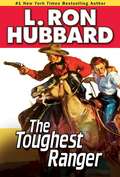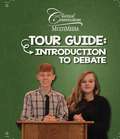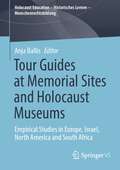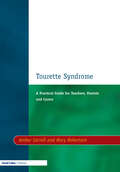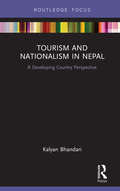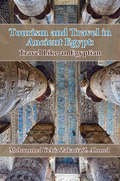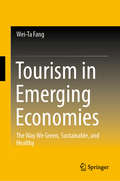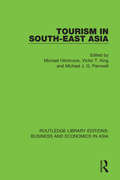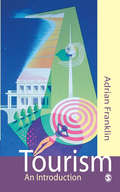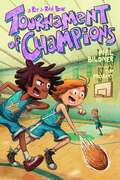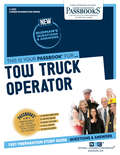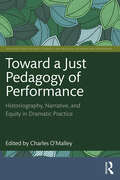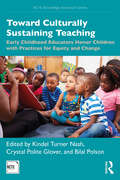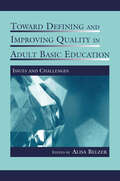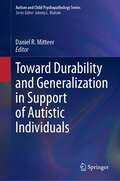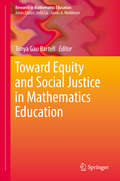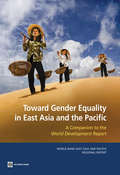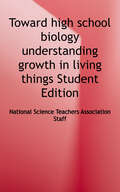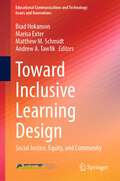- Table View
- List View
Toughest Ranger, The
by L. Ron HubbardEnjoy this tale from the wild, wild west. Cowboy Petey McGuire has been kicked around so much that he's turned forlorn, self-despairing and gun-shy. Yet starvation has a way of changing a man and so, armed only with his attitude and a hungry belly, Petey finds his way to the headquarters of the Arizona Rangers looking for a job.Petey also finds a new ornery personality; he claims to be the toughest man around from Kansas City to N'Orleans, a man so tough he'd give a rattler nightmares. But when the chief Ranger, Captain Shannon, calls Petey's bluff and sends him after the most dangerous desperado in the state, Petey must discover what it really means to be Ranger-tough. ALSO INCLUDES THE WESTERN STORIES "THE RANCH THAT NO ONE WOULD BUY" AND "SILENT PARDS""With the flair of a Louis L'Amour or Zane Grey.." --True West
Toulanika Sarkara Mattu Rajakiya: ತೌಲಾನಿಕ ಸರ್ಕಾರ ಮತ್ತು ರಾಜಕೀಯ
by Ramesha Sankaraddyಇದು ತೌಲಾನಿಕ ಸರ್ಕಾರ ಮತ್ತು ರಾಜಕೀಯ ಮೂಲಭೂತ ಪರಿಕಲ್ಪನೆಗಳು 2021/22 ರಿಂದ ಜಾರಿಗೆ ಬಂದ ರಾಷ್ಟ್ರೀಯ ಶಿಕ್ಷಣ ನೀತಿಯ ಅಡಿಯಲ್ಲಿ ರಾಜ್ಯಶಾಸ್ತ್ರದ ಐದನೇ ಸೆಮಿಸ್ಟರ್ ವಿದ್ಯಾರ್ಥಿಗಳಿಗೆ ಸೂಚಿಸಲಾದ ಪಠ್ಯಕ್ರಮದ ಪ್ರಕಾರ ಕರ್ನಾಟಕದ ಎಲ್ಲಾ ವಿಶ್ವವಿದ್ಯಾಲಯಗಳಿಗೆ ಅನ್ವಯವಾಗುವಂತೆ ವಿನ್ಯಾಸಗೊಳಿಸಲಾದ ಪುಸ್ತಕವಾಗಿದೆ.
Tour Guide: Introduction to Debate
by Classical Conversations MultiMediaThe point of this small book on debate is to teach beginning debaters the separate forms of team policy and Lincoln-Douglas debates. It does not explain the detailed nuances required to win competitive debates. This book is a companion to a video series that introduces debate through familiar conflicts and characters, teaching students to master the easier parts before they participate in a whole debate. If the structured arguments seem strange to you at first, remember that you learn lots of forms in other subjects: the form of the persuasive essay for writing about literature, the form of the syllogism for formal logic, the form of equations in mathematics, the form of the scientific method, and the form of sentence diagrams in English grammar. Debate is just one more form to master.
Tour Guides at Memorial Sites and Holocaust Museums: Empirical Studies in Europe, Israel, North America and South Africa (Holocaust Education – Historisches Lernen – Menschenrechtsbildung)
by Anja BallisIn this volume, contributors reflect on how to teach and mediate difficult history from the perspectives of guides. Too often, their activities are undervalued and taken for granted. Guides represent an important, often forgotten group of educators. This volume takes a global view on guiding at memorial sites and museums in Europe, North America, and South Africa. The contributors to this volume show from different research traditions that it is worth understanding more about the guides’ personal interests, their motivations, and their concept of guiding. Authors apply methodologies from the social sciences to describe the guides’ point of view. Complementing the various approaches in tour guide research, a detailed linguistic analysis sheds light on a survivor’s testimony echoed in the guides’ language. The studies gathered in this volume open up an orientation for further approaches to tour guiding based on and centered around “authentic” materials from guides.
Tourette Syndrome: A Practical Guide for Teachers, Parents and Carers (Resource Materials for Teachers)
by Mary Robertson Amber CarrollThis handbook provides the knowledge and information required to equip teachers and learning support assistants with the understanding and skills needed when working with pupils with Tourette syndrome. Clinical descriptions and medical treatments are discussed and advice on diagnosis, identification and assessment in the classroom is given. Responding to the learning, emotional and behavioural difficulties pupils may experience, the authors provide multi-disciplinary strategies for application within a school.
Tourism and Nationalism in Nepal: A Developing Country Perspective
by Kalyan BhandariThis book explores the role of tourism in the expression of nationalism in Nepal. It investigates assemblage of images, emblems, and symbols of Nepali nationhood in various touristic representations and narratives from Nepali travellers and diasporic visitors to showcase how they express nationhood and stimulate a strong sentiment of national feeling and belonging. The book suggests that touristic settings in Nepal provide a venue for articulation of nation, first through internal ascription, that is, the construction of identity by citizens with the nation; and second, through the promotion of distinctive touristic identity through the assertion of national uniqueness and distinguishing the nation within the larger international community. Given the recent great political changes, post-conflict nation rebuilding, and development, Nepal offers a fascinating case study on the role of tourism and nationalism. This book will be of great interest to students, scholars, and professionals working in tourism and heritage studies, sociology, anthropology, geography, political science, and area studies, as well as those interested in the study of developing societies.
Tourism and Travel in Ancient Egypt: Travel Like an Egyptian
by Mohammed Yehia Zakaria Z. Ahmed Becky Parker Chris PannyHow did the ancient Egyptians travel in this quaint old land thousands of years ago? What sort of transportation did they use? For how long did they go? What destinations did they visit? For which purposes did they travel? Is it correct to describe the ancient Egyptian travels as “tourism” or not? According to our current perceptions of tourism, if the Egyptians had tourism in ancient times, did they understand it as such? Which varieties of tourism did the ancient Egyptians have compared to what mankind has today? These and many more questions are answered in this ground-breaking book based on research, evidence, and artifacts by Egyptologist and Tourism expert Mohammed Ahmed. A fascinating exploration of hieroglyphs, ancient stories, language, art and more, and what they tell us about travel in ancient Egypt, while also informing our tourism experiences today. Indeed, we know that numerous aspects of the current global civilization derived from the ancient Egyptian civilization, such as writing, the scholarly calendar, medicine, architecture, festivals, chemistry, and other fields of life. The influence of the ancient Egyptian civilization on the modern world is clear. Climb aboard and tour Egypt with us - travel like an Egyptian!
Tourism in Emerging Economies: The Way We Green, Sustainable, and Healthy
by Wei-Ta FangThis book bridges the gap between the vital issues of the tourism industry, practices and destinations, discussing various topics from Asian and African perspectives. Each chapter presents extensive research on tourism development and tourism education, people’s work and travel experiences, as well as broader philosophies concerning the global tourism industry’s practices and operations. In the context of Sustainable Development Goals (SDGs) 8, 12 and 14, the book highlights the potential of tourism to contribute to economic growth, social inclusion and environmental preservation. It discusses crucial issues confronting the travel and tourism industry, presenting achievable outlines and strategy plans, and evaluating general theories, practices, and applications of social, economic and environmental aspects of management structure to maximize the cultural, social and ecological diversity of destinations and enhance the tourism experience. Providing a comprehensive guide to tourism and its related disciplines, it offers students, professors, entrepreneurs, and travel and tourism organizations insights into the trends, practices. Further, it features case studies ranging from historical and contemporary tourism to forecasts for future tourism.
Tourism in South-East Asia (Routledge Library Editions: Business and Economics in Asia #32)
by Victor T. King Michael Hitchcock Michael J. G. ParnwellSouth-East Asia has developed rapidly as a tourist destination, but what are the effects of this growth upon the peoples of the region? How far is it possible to control the impact of tourism whilst also supporting the industry's role in the region's development? This book, first published in 1993, attempts to answer these questions by providing a critical analysis of the nature of tourism as it has developed in the area. It questions commonly held assumptions about tourism both from a western perspective and from the point of view of policy makers in the region. It explores central issues such as the impact of tourism on the environment, culture and the economy, placing it within an historical and political context in order to assess the implications of current developments. The contributors use case studies from a variety of countries on such aspects as the sex industry, dream holidays and rural handicrafts, assessing tourist perceptions, both domestic and international, and policy decisions. By taking a long-term perspective it should provoke thought on the ways to develop sustainable tourism for the future.
Tourism: An Introduction
by Adrian Franklin`Argued with a real verve, it makes a plea to rethink the role of tourism in modernity seeing it not as a fleeting and marginal element, but as something enduring, emblematic and constitutive of contemporary society. Tourism is seen as a key element of modern life, not an escape from it' - Mike Crang, Department of Geography, University of Durham Tourism is a rapidly growing area of student enrolment. Lecturers and students who have waited patiently for an up-to-date, lucid and indispensable teaching and research text, need wait no more. This book is a matchless guide to understanding the theory, practice, development and effects of tourism. Tourism: An Introduction: - equips students with a critical perspective of the central processes of tourism and the relationship between tourism and culture - places tourism at the heart of modern life rather than as a peripheral feature added on after work - illuminates the relationship between tourism and nation formation, citizenship, consumerism and globalization - reveals the ritual, performative and embodied dimensions of tourist experience This book offers readers a major synthesis of modern thought on tourism. It breaks the mould of approaching tourism as a self-contained, compartment of contemporary life and treats it as a major and exciting cultural phenomenon. This is a landmark work in the study of tourism. Adrian Franklin is the editor of the acclaimed journal Tourist Studies (SAGE Publications).
Tourists in Historic Towns: Urban Conservation and Heritage Management
by Aylin OrbasliTourists in Historic Towns examines the relationship of culture, heritage, conservation and tourism development in historic towns and urban centres, debating the impacts of tourism on historic towns and the role tourism plays in conservation and urban continuity. The main focus of the book is medium sized historic towns and historic quarters which are attractive to the tourist market, but historic quarters in large cities and smaller rural settlements are not excluded. Alongside over a hundred examples of historic towns, five historic towns are discussed as case studies: Granada, Spain; York, England; Mdina, Malta; Antalya, Turkey and Quedlingburg, Germany.
Tournament of Champions
by Phil Bildner Tim ProbertIt's spring of their fifth-grade year and Rip and Red have a thrilling opportunity to participate in a weekend basketball tournament with a few other members of Clifton United. While the tournament is only a short bus ride away, both boys will travel outside their comfort zones. Ultra-competitive Rip must play on a team with kids he doesn't like. But he faces an even bigger hurdle when someone from his past returns, someone he hasn't seen in years, someone who just may derail the entire weekend. As for Red, because of his autism spectrum disorder, he's never traveled anywhere without his mother. Will he muster the courage to take the trip? Fortunately for both boys, also on the team is an unlikely addition, a source of inspiration who helps everyone discover the true meaning of the word champion. Tournament of Champions is the third book in Phil Bildner's Rip and Red series.
Tow Truck Operator: Passbooks Study Guide (Career Examination Series)
by National Learning CorporationThe Tow Truck Operator Passbook® prepares you for your test by allowing you to take practice exams in the subjects you need to study. It provides hundreds of questions and answers in the areas that will likely be covered on your upcoming exam.
Toward A Just Pedagogy Of Performance: Historiography, Narrative, And Equity In Dramatic Practice (Routledge Series in Equity, Diversity, and Inclusion in Theatre and Performance)
by Charles O’MalleyThis book is a compendium of resources largely by and for artists and scholars interested in engaging in conversations of justice, diversity, and historiography in the fields of theatre and performance studies. For these students, and for the future instructors in our field who will use this book, we hold a tripartite hope: to expand, to enable, and to provide access. In its whole, we intend for this book to provoke its readers to question the narratives of history that they’ve received (and that they may promulgate) in their artistic and scholarly work. We aim to question methods and ethics of reading present in the western mode of studying drama and performance history. The contributions in the book—not traditional chapters, but manifestos, experiences, articles, conversations, and provocations—raise questions and illuminate gaps, and they do not speak in a unified voice or from a static position. These pieces are written by artists, graduate students, teachers, administrators, and undergraduates; these are expressions of hope and of experience, and not of dogma. This book is aimed toward instructors of undergraduates, both graduate students and faculty at all levels of seniority within theatre and performance studies, as well as at artists and practitioners of the art that wish to find more just ways of viewing history.
Toward A Literate World: Television in Literacy Education: Lessons from the Arab Region
by Edward PalmerThis book documents the creation and evaluation of the Al Manaahil television series, which set out to teach Arabic language and reading skills to Arab children of elementary-school age. It also discusses the economics of television in education.
Toward A More Perfect University
by Jonathan R. ColeEducation has been disrupted dramatically by culture, technology and economics. The only certainty about the universities of the future is that they will not thrive if left unchanged. Jonathan Cole, John Mitchell Mason Professor at Columbia University, and its former provost, is one of the country's leading academic researchers into higher education. A fierce champion of the merits and benefits of the great American research university, Cole identifies the potential fault-lines that threaten the future of universities and the strategic changes that successful colleges will have to make in order to preserve their intellectual relevance, economic viability and social mission. In turn he examines: Admissions policies; Examinations; Cost; Undergraduate education; The role of the humanities The place for professional schools; Research campuses of the future; Sports; Leadership and governance; The intellectual and legal threats to academic freedom. Using his deep knowledge of the history and traditions that underpin US higher education, Cole separates the essential from the fashionable. Higher education is a vital national resource, and an economic proving ground. It is the bedrock of American business and society and it must adapt in order to remain globally competitive and intellectually valuable. The culture of the great American universities reflects the moral and social foundations of the republic itself: they are a litmus test of values and philosophies, and their future affects everyone.
Toward Culturally Sustaining Teaching: Early Childhood Educators Honor Children with Practices for Equity and Change (NCTE-Routledge Research Series)
by Kindel Turner NashDemonstrating equitable practices and strategies that move toward culturally sustaining teaching such as translanguaging, explorations of children’s literature, alternative modes of literacy assessment, photography and arts integration, student-driven poetry units, and more, this book shares the stories of four teacher–teacher dyads who worked together across university–school contexts to study, generate, and evaluate culturally relevant and sustaining literacy practices in early childhood classrooms across the country. Highlighting the voices and roles of children, families, community members, and teachers of Color, this book suggests new ways for all teachers to build and sustain relationships that are relevant and work toward being sustaining; and anticipates and offers solutions for challenges that arise in these contexts. Insightful and instructive, the narratives in this collection model how to create positive and mutually beneficial dynamics among teachers, children, and their families and communities. This book offers a timely resource for pre-service teachers, teachers, scholars, faculty, and graduate students in language and literacy education, early childhood education, and culturally relevant, responsive, and sustaining teaching.
Toward Defining and Improving Quality in Adult Basic Education: Issues and Challenges (Rutgers Invitational Symposium on Education Series)
by Alisa BelzerThis volume revisits, problematizes, and expands the meaning of quality in the context of adult basic education. Covering a wide range of relevant topics, it includes contributors from the realms of both policy and practice and encompasses both the major instructional areas-reading, writing, and mathematics-as well as larger issues of literacy, learning, and adulthood. Each chapter focuses on what improving quality in the field might look like through the particular lens of the author's work. As a whole, the broad scope of topics and ideas addressed will raise the level of discussion, knowledge, and practice regarding quality in adult basic education. In this book, the term adult basic education refers to the broad range of services for adults who wish to improve their literacy and language skills, including beginning and intermediate writing, writing and numeracy, preGED, GED/Adult Secondary Education, and ESL instruction that takes place in a range of contexts including schools, community-based programs, and workplace development programs. The volume is organized around three themes:*Accountability, Standards, and the Use of Documentation and Research;*Program Structures and Instruction; and*Rethinking Our Assumptions and Concepts. Coming at a time of increasing pressure to standardize, to be accountable, and to improve outcomes, and when calls for evidence-based practice are fueling stakeholders' interest in the relationship between research and practice at all levels of the system, Toward Defining and Improving Quality in Adult Basic Education is particularly timely for scholars, graduate students, and professionals in the field of adult basic education.
Toward Durability and Generalization in Support of Autistic Individuals (Autism and Child Psychopathology Series)
by Daniel R. MitteerThis book describes methods for improving the maintenance and generalization of behavior analytic treatment outcomes for individuals with autism. It introduces the concept of durability—not just treatments that maintain across days or weeks, or that generalize to a few new settings, but those that remain successful under increasingly challenging situations (e.g., over years, during changing reinforcement conditions, across service providers). Chapters address key topics, such as preventive care, early behavioral intervention, treatment of severe destructive behavior, teaching skills across the lifespan, and medication management. In addition, the book addresses ethical and cultural considerations as they relate to treatment maintenance and concludes with perspectives from autistic voices and caregivers. Chapters include case examples highlighting durable outcomes as well as schematics and materials (e.g., data sheets) to assess and maintain treatment gains. Key areas of coverage include: Behavioral persistence, durability of treatment effects, and relapse across the following domains. Early learner and academic skills. Toileting and self-care skills, feeding behavior, and verbal behavior. Social skills and socially reinforced destructive behavior. Automatically reinforced destructive behavior. Medical compliance, implementer behavior, and geriatric behavior.
Toward Equity and Social Justice in Mathematics Education (Research In Mathematics Education Ser.)
by Tonya Gau BartellThis critical volume responds to the enduring challenge in mathematics education of addressing the needs of marginalized students in school mathematics, and stems from the 2015 Annual Meeting of the North American Group of the Psychology of Mathematics Education (PME-NA). This timely analysis brings greater clarity and support to such challenges by narrowing in on four foci: theoretical and political perspectives toward equity and justice in mathematics education, identifying and connecting to family and community funds of knowledge, student learning and engagement in preK-12 mathematics classrooms, and supporting teachers in addressing the needs of marginalized learners. Each of these areas examines how race, class, culture, power, justice and mathematics teaching and learning intersect in mathematics education to sustain or disrupt inequities, and include contributions from scholars writing about mathematics education in diverse contexts. Included in the coverage: Disrupting policies and reforms to address the needs of marginalized learnersA socio-spatial framework for urban mathematics educationLinking literature on allywork to the work of mathematics teacher educatorsTransnational families’ mathematical funds of knowledgeMultilingual and technological contexts for supporting learners’ mathematical discoursePreservice teachers’ strategies for teaching mathematics with English learners Toward Equity and Social Justice in Mathematics Education is of significant interest to mathematics teacher educators and mathematics education researchers currently addressing the needs of marginalized students in school mathematics. It is also relevant to teachers of related disciplines, administrators, and instructional designers interested in pushing our thinking and work toward equity and justice in mathematics education.
Toward Freedom and Dignity: The Humanities and the Idea of Humanity
by O. B. Hardison Jr.Originally published in 1973. Toward Freedom and Dignity is a humanist's view of the humanities in an age of burgeoning technology. O. B. Hardison Jr. deals with the status of the humanities and their future—how they are regarded and how they may come to contribute to a genuinely humane society. He argues that humanistic studies are not a luxury in either education or society. They are central to the preparation of human beings for the kind of society that is possible if we manage to avoid an Orwellian technocracy. Social goals and priorities must be set in terms of the ideal of a culture truly adjusted to human needs and human limitations. In framing his argument, Hardison draws on ideas of the humanities since the Renaissance, especially on the philosophical humanities that emerged in Europe in the works of authors like Kant, Schiller, and Coleridge. He is untroubled by anti-humanistic trends in college curricula and the surrounding culture, and he contends that we have only one practical option: to ensure that culture evolves toward a more humane society, toward freedom and dignity.
Toward Gender Equality in East Asia and the Pacific: Companion to the World Development Report
by The World BankToward Gender Equality in East Asia and the Pacific examines the relationship between gender equality and development and outlines an agenda for public action to promote more effective and inclusive development in East Asian and Pacific countries. Written as a companion to the World Development Report 2012 on gender equality and development, the report finds that promoting gender equality contributes to higher productivity, income growth, and poverty reduction; improves the opportunities and outcomes for the next generation; and enhances the quality of development policymaking. It contributes to the understanding of gender and development policymaking in several important ways. First, the report presents new data and evidence that significantly strengthen the empirical basis for policymaking on gender and development in the region. Second, the report provides new analysis of the gender dimensions and policy implications of several global trends that are particularly important in the region, including increasing economic integration, rapid adoption of new information and communication technologies, rising domestic and international migration flows, rapid urbanization, and population aging.
Toward High School Biology: Understanding Growth in Living Things
by National Science Teachers Association StaffThrough 19 carefully sequenced lessons and activities, this unit gets middle schoolers ready for next-level learning. Students explore what happens at the molecular level so they can understand how living things grow and repair their body structures. Using Legos, ball-and-stick models, videos, and print manipulatives helps them retain what they learn so they can apply that knowledge later. <p><p>Both effective and engaging, Toward High School Biology Draws on a research-based development approach. Multiple cycles of design and revision based on results from classroom field tests, feedback from teachers, expert scientific input, and criteria-based evaluations ensure the high quality of the unit. Takes an interdisciplinary approach. Lessons focus on phenomena related to chemical reactions that take place in both physical and life science contexts, from the rusting of a metal bicycle to the production of muscles in humans. Supports the Next Generation Science Standards. All three dimensions of science learning science and engineering practices, disciplinary core ideas, and crosscutting concepts are carefully integrated in each chapter. It is refreshingly easy to use. <p><p>The Student Edition should be used in conjunction with the Teacher Edition, which provides complete lesson plans and instructions for carrying out the activities. Complementary video demonstrations and tutorials are available online. <p><p>Toward High School Biology, Student Edition provides the materials you need to guide your students through these investigations. With lesson details, teacher facilitation pages, and handouts, your students will be ready to start investigating.
Toward Inclusive Learning Design: Social Justice, Equity, and Community (Educational Communications and Technology: Issues and Innovations)
by Brad Hokanson Andrew A. Tawfik Marisa Exter Matthew M. SchmidtThis book examines how society has been affected by the social upheaval of the years since George Floyd’s death and efforts by those in education and educational technology to address the concerns of equity, community and social justice. This book is a practical yet scholarly guide in the pursuit of inclusive design, drawing from a diverse range of authors with a broad range of application and theory. The chapters go beyond a narrow view of inclusive learning design, and address issues in a broad range of fields. This book is appropriate for all levels of learning, with a distinct focus on higher education and graduate education.
Toward Independence: The Use of Instructional Objective in Teaching Daily Living Skills to the Blind
by Anne YeadonThis book is an introduction to the use of instructional objectives in the teaching of severely visually impaired persons. While it happens to use a daily living skills course as an example of how a teacher might develop a course around this educational method, it is not a daily living skills teaching manual. A creative teacher should be able to adapt the approach as described in Toward Independence to many other subjects.
